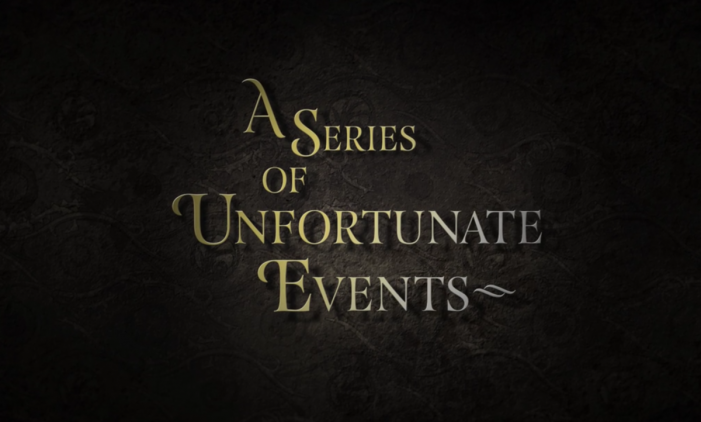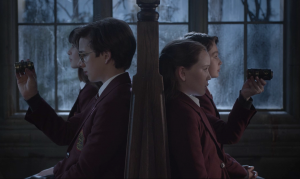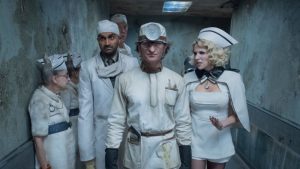Dear Reader. I regret to inform you that the story of the Baudelaire orphans in the second season of Netflix’s A Series of Unfortunate Events is even darker and more dismal than the first. However, I am thrilled to impart that it is another strong outing for the show. In some ways, it even improves upon its predecessor, a word which here means… *ahem* Sorry about that. It’s easy to get caught up in the world of the show after watching several episodes back to back. The world building of this season in particular is fantastic. After narrowly escaping Count Olaf’s schemes and going from one guardian to another, the Baudelaire orphans actively investigate the mystery of the secret society their parents were members of. Their quest takes them from locations ranging from a town obsessed with crows to a hospital sorely lacking in effective healthcare.
Season two adapts books five through nine of the series. Fans of the books will note that this section of the series in where the overarching secret organization plot really came into play. While the first season did a great job of retroactively inserting it into its story, here its feels more natural and connected to the individual episodes. Once again, the show splits each book into two episodes. This time it adapts five instead of four. This gives the show room to breath. It also helps that books five through nine are significantly longer, so there’s less fleshing out.
Caution: Mild Spoilers. You’ve been warned.
The Austere Academy (Parts 1 and 2)
In “The Austere Academy” we find the Baudelaire children right where we left them. On a bench in Prufrock Preparatory School. Both they and the Quagmire twins (sorry, triplets) sitting behind them make meta-comments on how it feels like they’ve been sitting there for months. Luckily, the two groups of orphans become fast friends. Duncan and Isidora, who lost their brother Quigley in a fire, decide to help the Baudelaires keep the scheming Count Olaf away. Adding to the Baudelaire’s misfortune is the fact that they have to live in a shack and are subject to the bullying of Carmelita Spats. Kitana Turnbull is appropriately annoying as Carmelita, hamming the character up without totally going overboard.
Just like with the first season, the opening installments of the second series are easily its weakest. That’s not to say they’re not good. Rather they just take more time to set things up and the stakes never feel high. Part of this is due to Count Olaf taking a long time to arrive at the school. Even when he does catch up, it takes him a while to find a disguise and a way to infiltrate the school, which has a so-called “advanced” computer system looking for him. While Neil Patrick Harris is great at playing the personas of Olaf’s myriad disguises, he’s at his weakest when playing Olaf himself. The villain spends almost the entire first episode out of costume, and never feels threatening. Instead we’re treated to a variety of jokes about his school days that never quite land and make him seem even less cunning.
While Olaf takes a back seat in this episode, the supporting characters steal the spotlight. Roger Bart and Nathan Fillion, underused actors in my opinion, shine as the musically challenged Vice Principal Nero and Jacques Snicket, the daring secret agent brother of narrator Lemony. Sarah Rue gives a delightful performance as librarian Olivia Caliban. Olivia and Jacques don’t show up in the books until later in the series, but the choice to add them early so the audience gets to know them is a great one. The episodes contain a few good jokes about the banality of schoolwork and triviality of school spirit. The school’s mascot, for example, is a dead horse, since it “can’t be beat.” This send up of school culture highlights a running theme of this season, which pokes fun at various forms of institutions and how they can often fail the very people they’re designed to help.
The Ersatz Elevator (Parts 1 and 2)
After the Baudelaires leave their brief time at boarding school, they’re taken in by Jerome Squalor, a rich friend of their parents. Why hadn’t he offered to adopt them sooner? Well according to his high-society obsessed wife Esme, orphans were not “in” until now. Realizing that Count Olaf has hidden their friend the Quagmires nearby, the Baudelaires set out to find them. Meanwhile, Jacques recruits Olivia to the cause of the VFD, the secret organization he’s a part of.
Unlike the first set of episodes, Count Olaf shows up immediately in “The Ersatz Elevator,” and the episodes are all the better for it. He’s disguised as Gunther, a foreign auctioneer of indeterminable national origin. Harris manages to make Gunther humorous while remaining sinister. Lucy Punch also excels as Esme, and is likewise able to strike a balance between vain and self-absorbed and cruelly calculating.
The first episode of “The Ersatz Elevator” is quite predictable and relatively low stakes, but the second is where the season really hits its stride. Betrayals, mysteries, and daring feats abound. It even includes a musical number. The ending of the episode is especially poignant, as the Baudelaires actively shift from trying to avoid danger to actively pursuing it in order to rescue their friends, even as they’re given the possibility of finding safety.
The Vile Village (Parts 1 and 2)
The Baudelaires search for the Quagmires and the identity of the secret organization takes them to a town in the middle of nowhere. With the same initials as the secret society, VFD, the children hope that it’ll shed some light on their predicament. It just so happens that the motto of the village is “it takes a child” and that the townsfolk have offered to care for the children. Of course, everything in their world has a catch, and in reality the villagers just want someone to do their chores. It’s also worth mentioning that the town is covered in crows and run by a rule-worshiping council, a satire of bureaucracy.
Although few of the villagers care at all for the children, they live with Hector, played with wide-eyed wonder by Ithamar Enriquez. Unfortunately, Hector is deathly afraid of the council and feints whenever in its presence, which Enriquez does convincingly and humorously. If the crows and “ghost town” vibe of the village don’t convey it, this section in the story employs more gravitas than those before. It also shakes up the formula of the Baudelaires going from guardian to guardian trying to hide from Count Olaf. This time, they’re looking for him. While Hector becomes a guardian of sorts, they’re not technically adopted by him and mostly take care of him instead of the other way around.
Even as Count Olaf’s Detective Dupont disguise marks a step down and borders on grating, it becomes evident than the Baudelaires are more the victims of a system more than one man. Esme adopts a fun persona as a police chief with an Italian name that seems to get longer the more she says it. As this character, she’s able to warp the justice system of the town while going toe-to-toe with Jacques and Olivia, who arrive on the scene. Suddenly, the episode feels a bit weightier. This is no longer just the story of the Baudelaires, but that of the conflict they’ve become embroiled in involving two rival factions of a secret society. The plans of each side pull in the town and the Baudelaires and become so twisted that they cause the seemingly rational townsfolk to chant cries of “burn the children!” It’s macabre, yes, but also a relevant look at how laws and justice systems can become abused.
The Hostile Hospital (Parts 1 and 2)
The Baudelaires wind up at Heimlich Hospital after getting a ride from a group known as VFD. Of course, it’s the wrong VFD, as this one’s initials stand for Volunteers Fighting Diseases. And how do they fight diseases, pray tell? By singing and giving patients heart-shaped balloons. This is a great example of the series nailing dark humor. Luckily for the Baudelaires, they find that the hospital has an extensive Hall of Records, overseen by the kindly Hal, played with grandfatherly care by David Alan Grier. Hal keeps the system so well-organized that information from all over the world is sent to it, on all different subjects. Here the Baudelaires hope to find more information on the real VFD.
As grim as “The Vile Village” is, “The Hostile Hospital” is dark. Very dark. Yet it nevertheless knows how to have fun by leaning into its dark humor. There are a number of truly tense moments, including a fun homage to horror movies in which Olaf and his troupe attempt to scare Babs, Head of HR, into giving them control of the hospital. Esme gets a great scene in which she proves herself as a daunting adversary for the Baudelaires, and the situation the children are put in becomes especially dire.
This season marks the shift for the Baudelaires in which they start to take action. “The Hostile Hospital” shows that their actions have consequences. Forced to make a tough decision, the children end up deeply hurting their new friend Hal. Surprisingly, the episode does not give the Baudelaires a moment in which they redeem themselves nor does it brush aside their transgression. It highlights the fact that they’re no longer seen as children who don’t know any better. Although this causes the episode to end on a sadder note, it sets up the audience for the significance and unrelenting nature of the season’s final set of episodes.
The Carnivorous Carnival (Parts 1 and 2)
These last two episodes are the best of the season, if not the whole show. Whereas the stakes felt low in the first two, here they feel like they couldn’t be higher. Forced to hide in Olaf’s trunk to escape the hospital, the Baudelaires end up at Caligari Carnival. Olaf learned that here he’ll find Madame Lulu, a medium who can supposedly predict the future. Naturally, the Baudelaires are hoping to intercept any knowledge she has to impart and find out if one of their parents survived the fire that destroyed their home.
Much like with the finale of season one, these last two episodes provide much of their appeal through the fact that they’re the climax of the season’s story-line. The actual plot taken from the books is fine, and the design of the run-down carnival is fittingly equal parts goofy and gloomy. The real mileage comes from the overarching story coming to a head. This kicks off immediately with an absolutely fantastic opening. The flashback sequence reunites us with many familiar faces and is thrilling in its own right. This and the many other callbacks peppered through the two episodes really put the events of the whole series into perspective. Since the books focused almost entirely on events from the Baudelaire’s perspectives, it’s touches like these that show the value of adapting the series to a format that can quickly highlight various points of view.
While this season gradually gravitates towards more depth and weightiness, the second episode of the set packs an emotional punch. While I’d have been surprised to find such a tense ending among all the lighthearted moments of season one, this time the season earns it. Ending on a very different note than the tongue-in-cheek musical sign-off of the first, the second season sets things up for what should be a very interesting third and final season indeed.
Strikes the perfect balance between lighthearted comedy and deep themes
A Series of Unfortunate Events Season 2 uses the more intricate plots and themes of the middle books in the series to its advantage. Despite another slow opening, events build to even higher highs and lower lows as the series leans into the through line of its overarching plot and steps away from the pre-established formula. Great performances from character actors and wild set designs make the choice to watch the show a Very Fine Decision.
-
A Series of Unfortunate Events Season 2
-
The Austere Academy
-
The Ersatz Elevator
-
The Vile Village
-
The Hostile Hospital
-
The Carnivorous Carnival







